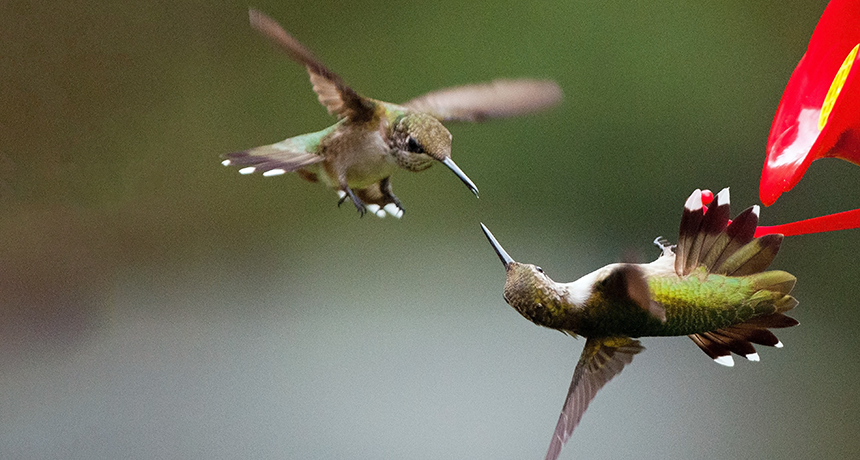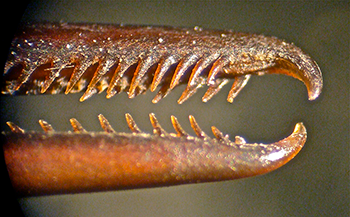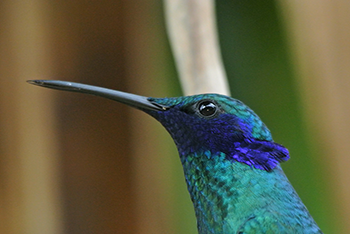Some male hummingbirds wield their bills as weapons
Some species may trade feeding efficiency for fighting prowess

Hummingbirds fight over a feeder. The shapes of some male bills appear to have evolved to equip them for such combat.
CarolinaBirdman/iStockphoto
A hummingbird’s long, curved bill (or beak) is perfectly designed to sip the nectar deep inside trumpet-shaped flowers. In fact, the types of flowers a species will visit are closely tied to the shape of the birds’ beaks. Long, narrow flowers, for instance, are visited by hummers with equally long bills. Flower shape equals bill shape. But there’s more to that equation, suggests a new study. And it involves a fair amount of combat.
For decades, scientists had argued that the shape of hummingbird bills must depend on the flowers these birds tap for food.
Some hummingbirds can beat their wings up to 80 times per second. This lets them zip from flower to flower and hover while eating. But all that movement requires a lot of calories. Hummingbirds sip plenty of sugary nectar to fuel that activity. Bills that fit perfectly inside flowers help birds reach more nectar and drink it down faster. Their long tongues lap up the sweet reward located at the base of the bloom.
Flowers pollinated by those birds get more pollen moved from flower to flower, because these birds tend to visit the same types of flowers again and again. So the close tie between bill shape and flower shape seemed like an open-and-shut case of co-evolution. (That’s when the traits of two different species that interact in some way change together over time.)

Except for one thing: Males of some tropical species don’t show the same bill adaptation to fit flowers that the females have. Instead, their bills are stronger and straighter with pointy tips. Some even have sawlike structures along the sides. In short, they kind of look like weapons. They are not slicing open flowers. So what’s up with their beaks?
Maybe males and females simply feed from different types of flowers, scientists proposed. That might explain their different bills. But Alejandro Rico-Guevara was not convinced. He’s an evolutionary biologist at the University of California, Berkeley. And he has a passion for hummingbirds.
There’s another difference between the sexes, he notes: Males fight one another. Each defends a territory, and all of the flowers and females within it. He thinks that competition between males — and the combat that results — led to the weapon-like features on the guys’ bills.
Taking it slow
Studying hummingbirds isn’t easy. They’re fast fliers, clocking in at speeds up to 55 kilometers per hour (34 miles per hour). They can change direction in an instant. But Rico-Guevara knew that if males had weaponized bills, it would come at a cost. Bills designed to fight would not be as well adapted to eating. So he first had to learn how hummingbirds drink nectar to test his hypothesis.
To do that, he teamed up with researchers at UC Berkeley and the University of Connecticut in Storrs. Using high-speed cameras, they filmed hummingbirds feeding and fighting. They placed some cameras underneath hummingbird feeders. This let the scientists record how the birds used their bills and tongues while drinking. The researchers used the same high-speed equipment to record males fighting.

Slowing down the videos, the team saw that hummingbirds lap up nectar with their tongues. This was a new discovery. Before this, scientists thought nectar moved up the tongue almost like liquid sucked up a straw. Instead, they found that the tongue unfurls as it enters liquid, like a palm frond opening. This creates grooves, allowing the nectar to flow in. When the bird pulls its tongue back in, its beak squeezes the nectar out of those grooves and into its mouth. Then the bird can swallow its sweet reward.
Females, the team found, had curved bills that were perfectly designed to max out the amount of nectar picked up in each sip. But the straighter beaks of some males didn’t seem to get as much out of each drink.
Slow-motion video of males fighting showed that those straight bills might have an advantage in combat, though. These birds stab, bite and pull feathers from males invading in their territory. Straighter bills are less likely to bend or be damaged than curved ones. It’s like poking someone with a straight finger, rather than one that’s bent, explains Rico-Guevara. The pointy tips make it easier to jab through a protective layer of feathers and pierce the skin. And the birds use the sawlike “teeth” along the edges of some bills to bite and pluck feathers.
“We were really surprised by these results,” says Rico-Guevara. This was the first time anyone had seen what happens when male hummingbirds fight. No one knew they wielded their bills as weapons. But that behavior helps explain some of the strange structures found on the males’ bills.
It also highlights the trade-offs these birds face, he says. His team is still studying the videos of males feeding. But if they really get less nectar per sip, it would suggest they can either be good at getting food, or good at defending flowers from others (keeping the food to themselves) — but not both.
His team’s findings were published January 2 in Interactive Organismal Biology.
Rico-Guevara has many more questions. For example, why don’t males in all species that fight have weapon-like bills? Why don’t females have these features? And how could such structures evolve over time? He has experiments planned to test these and other questions in the future.
This study shows there’s still a lot to learn, even about birds that people thought they understood well, says Erin McCullough. The behavioral ecologist at Syracuse University in New York was not involved with this study. Its findings also highlight how an animal’s shape and body structures almost always reflect trade-offs, she notes. “Different species prioritize different tasks,” such as feeding or fighting, she says. And that affects how they look.
UC Berkeley/YouTube







